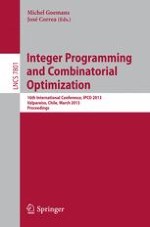This book constitutes the proceedings of the 16th International Conference on Integer Programming and Combinatorial Optimization, IPCO 2013, held in Valparaíso, Chile, in March 2013. The 33 full papers presented were carefully reviewed and selected from 98 submissions. The conference is a forum for researchers and practitioners working on various aspects of integer programming and combinatorial optimization with the aim to present recent developments in theory, computation, and applications. The scope of IPCO is viewed in a broad sense, to include algorithmic and structural results in integer programming and combinatorial optimization as well as revealing computational studies and novel applications of discrete optimization to practical problems.
